Cats are known for their love of exploring and jumping into spaces that we may not want them to. One common problem faced by cat owners is keeping their curious feline friends out of cabinets. Not only can cats make a mess in cabinets, but they can also potentially get hurt or ingest something harmful. In this guide, we will discuss some effective methods on how to keep cats out of cabinets.
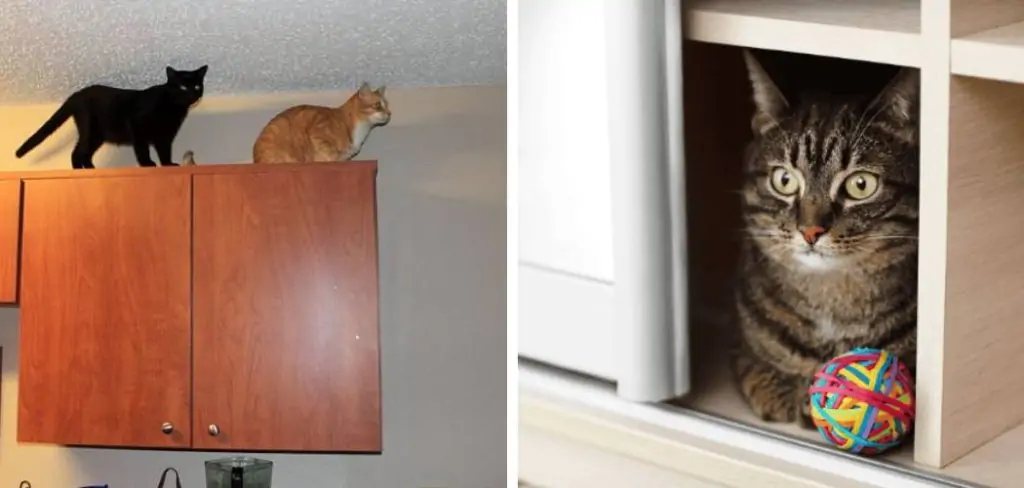
Why Cats Love Cabinets
Before we dive into the solutions, it’s important to understand why cats are drawn to cabinets in the first place. Here are some reasons why:
- Dark and Cozy Spaces: Cats love small, enclosed spaces because they provide a sense of security and comfort.
- Curiosity: Cats are naturally curious creatures and will investigate any new and interesting space they come across.
- Hunting Instincts: Cabinets are usually full of hidden nooks and crannies, making them the perfect place for a cat to hunt for potential prey.
Now that we know why cats love cabinets, let’s discuss some methods on how to keep them out.
10 Ingenious Ways to Keep Cats Out of Cabinets
Cats have a notorious talent for getting into spaces they shouldn’t—especially cabinets. Whether you’re trying to protect your valuables, keep them out of potentially hazardous spaces, or just want to give your feline friend boundaries, there are numerous tactics you can employ. Here are 10 ingenious ways to keep your furry companions out of your cabinets.
1. The Power of Redirection
Sometimes, simple redirection is the most effective tactic. Invest in some interactive toys to keep your cat distracted and engaged. Place these near the areas you want to protect and encourage positive behavior. Make sure that the toys are replaced or rotated regularly to keep your cat’s interest piqued.
2. Double-Sided Sticky Tape
Cats generally don’t like the sticky feeling of double-sided tape on their feet. Placing this tape around the cabinet edges and inside where they might walk can discourage your pets from entering. Just be sure to replace the tape regularly as it loses its stickiness, and avoid using especially strong adhesives that could damage your cabinet surfaces.
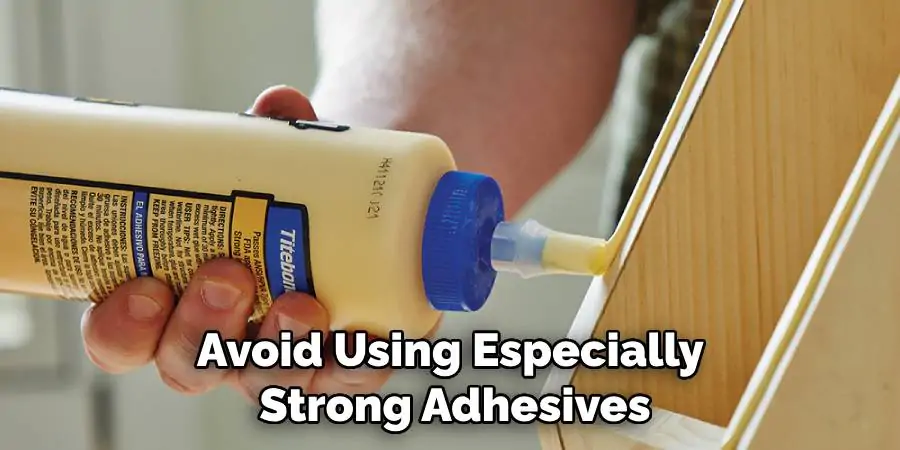
3. Scent Deterrents
A cat’s sense of smell is highly developed, and certain scents are unappealing to them. Consider using natural repellents like citrus peel or essential oils with strong citrus or menthol scents. Mothballs may also be effective but use them with caution as they can be toxic to cats.
4. Ultrasonic Repellers
High-frequency devices can be installed inside or on the cabinet to emit a sound that’s irritating to cats but unheard by human ears. These devices are motion-activated, so the cat’s movement triggers the sound, making it an excellent deterrent without causing any harm.
5. Positive and Negative Reinforcement
If you’re dealing with a persistent cat, training through reinforcement could be an effective option. Use positive reinforcement when your cat stays away from the cabinets—treats, praise, or play time can work wonders. Conversely, a short, sharp noise like a hand clap can deter them when they misbehave.
6. Physical Barriers
Sometimes, a barrier is the most straightforward solution. Install childproof locks or latches on your cabinets that are tricky for cats to get past. Magnetized locks are a perfect balance between security and ease of use for humans.
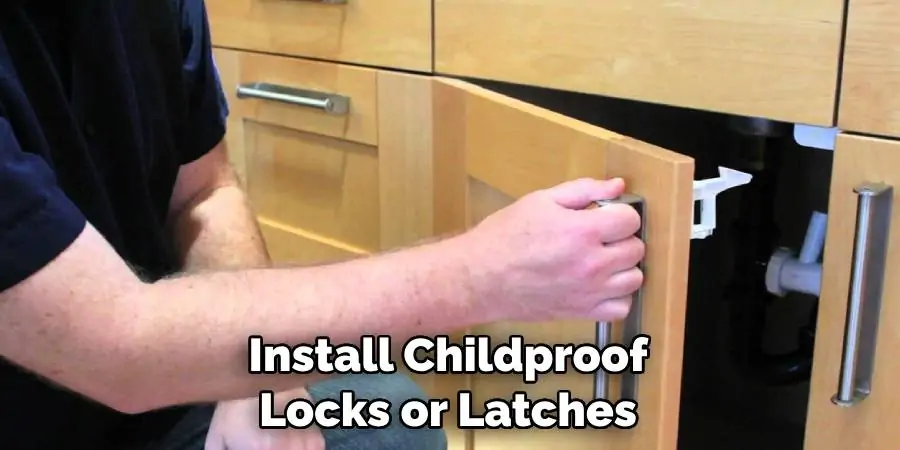
7. Educate With Environmental Clues
Make the areas you want to protect less appealing for your cat by creating physical or visual cues. For example, you can leave a door slightly open with a can filled with pennies perched on the top, secured by a string so it falls with the slightest touch. The instant loud noise can be an effective deterrent.
8. Make Use of Water
Most cats don’t appreciate getting wet. A motion-activated water sprayer placed at the cabinet entrance can provide a harmless but effective reminder that they’re not supposed to be there. Keep in mind, water should be used sparingly and not as a primary training tool.
9. Adjust the Cabinet Environment
Cats often seek out dark, cozy spaces, and cabinets are a perfect fit. Make changes to the environment that will make the cabinets less appealing. Bright interior lighting, non-slip shelf liners, or even simply taking a smelly pair of shoes from the bottom can change their appeal.
10. Implement Proper Training Responses
When your cat does show interest in the cabinets, it’s vital to respond appropriately. This includes not giving them attention for the undesired behavior, immediately directing them to a more appropriate area, or eliciting a natural consequence such as a door or gate closure. Consistency is key in training.
By employing one or a combination of these tactics and remaining consistent in your approach, you can teach your feline friend to respect the boundaries you set without damaging your relationship. Remember, patience and creativity will be your best allies in dealing with these little imps.
How to Train Cats to Stay Out of Cabinets
Training cats to stay out of cabinets can take time and patience, but with the right approach, it is possible. Here are some steps you can follow to train your cat to stay away from cabinets:
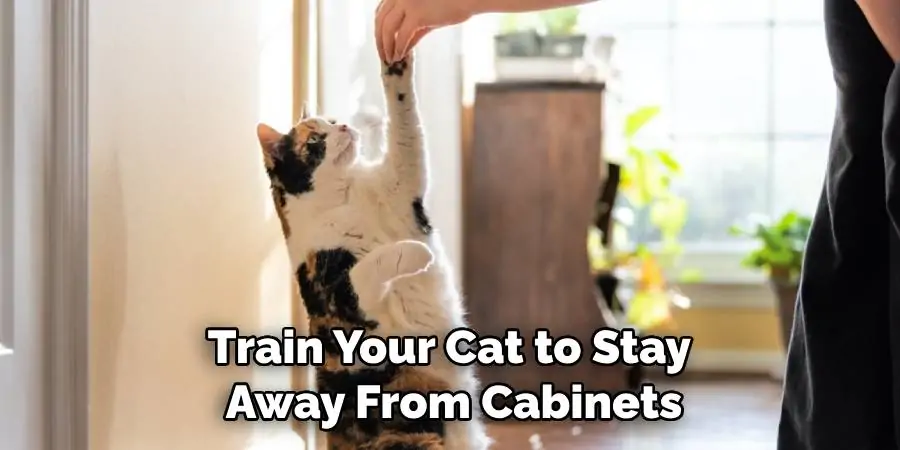
- Identify the Problem: Before you start training, it’s essential to understand why your cat is going into the cabinets in the first place. Is it seeking a dark, cozy spot to nap in? Or is it drawn to the smell of food or treats inside? Knowing the reason can help you come up with a targeted solution.
- Provide Alternatives: Cats are curious creatures, and they need mental stimulation and playtime. Make sure your cat has designated areas where it can play and explore, such as scratching posts or puzzle toys. This will help redirect their attention away from cabinets.
- Use Deterrents: Cats are sensitive to certain smells, textures, and sounds. You can use these deterrents to discourage your cat from entering the cabinets. Options include placing double-sided tape on cabinet surfaces, using citrus-scented sprays, or installing motion-activated alarms.
- Reinforce Positive Behavior: When your cat stays away from the cabinets, reward them with treats and praise. This will reinforce positive behavior and encourage your cat to repeat it in the future.
- Be Consistent: Training takes time and consistency is key. Make sure everyone in your household follows the same rules and responds appropriately when your cat shows interest in the cabinets.
- Seek Professional Help: If your cat’s behavior persists despite your best efforts, consider seeking help from a professional animal behaviorist who can provide personalized solutions for your specific situation.
Remember, every cat is unique and may respond differently to training methods. Be patient and persistent, and soon enough you will have a feline friend who respects the boundaries you set while still enjoying playtime and exploration in a safe and appropriate manner. Ultimately, training your cat to stay out of cabinets is all about finding the right balance between discipline and love in your relationship with your furry companion. With time and effort, you can achieve a harmonious household for both you and your feline friend.
Frequently Asked Questions
Why Does My Cat Go in Cabinets?
Cats are renowned for their curious nature, often exploring their environment to the most unexpected places, including the secluded confines of kitchen cabinets. This particular feline behavior can be both amusing and bemusing for pet owners. If you find yourself pondering, “Why does my cat go in cabinets?” consider that these spaces provide a sense of security and solitude that is irresistibly appealing to your whiskered companion.
The dark, enclosed space mimics the snug dens wild cats might seek out – a place where they can observe without being seen, and retreat to for a peaceful nap. However, as adorable as this may seem, it can also lead to broken dishes or lost kitties. For those seeking solutions on how to keep cats out of cabinets, there are several cat-proofing strategies such as childproof locks, sticky tape, or simply providing an alternative cozy spot for your curious pet.
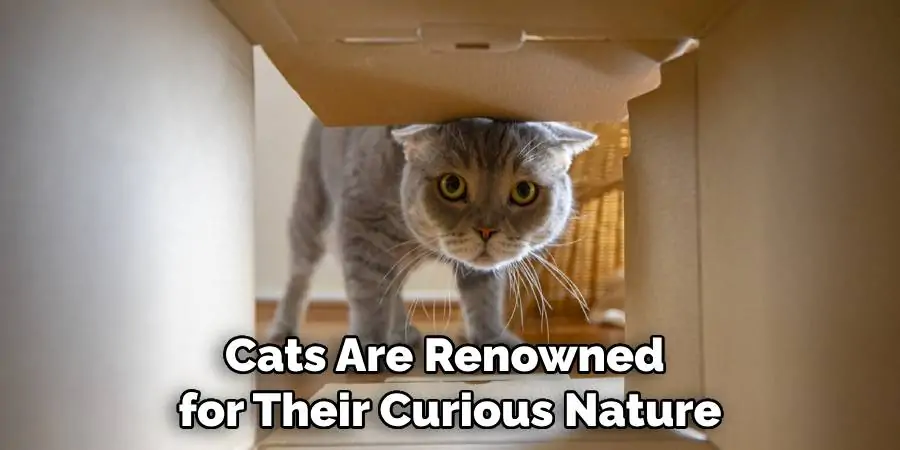
How Do I Keep Pets Out of My Cabinets?
Keeping pets out of cabinets can be a frustrating problem for many pet owners. Not only is it a nuisance, but it can also pose potential dangers to both your pet and your valuables. Fortunately, there are several effective methods you can employ to keep your furry friends out of your cabinets.
Firstly, try redirecting their attention with interactive toys or providing a designated play area near the cabinets to keep them occupied. You can also use deterrents such as sticky tape, scents, or ultrasonic devices to discourage your pets from entering. Physical barriers and environmental cues can also be effective in deterring curious cats.
Lastly, it’s essential to respond consistently and appropriately when your pet shows interest in the cabinet, whether it’s through redirecting their behavior or implementing natural consequences. With patience and persistence, you can train your pets to respect the boundaries you set while maintaining a positive relationship with them.
Can I Use Citrus Essential Oils as a Cat Deterrent?
Yes, citrus essential oils can be used as an effective cat deterrent. Cats have a strong sense of smell, and certain scents are unappealing to them. Citrus oils, in particular, have a strong smell that is unpleasant for cats and can discourage them from entering certain areas. However, it’s essential to use these oils with caution as they can be toxic to cats. It’s best to dilute the oils and use them in areas where your cat is not likely to come into direct contact with them.
Conclusion
In this guide, we’ve discussed various tactics that can be employed on how to keep cats out of cabinets. From positive and negative reinforcement to physical barriers and environmental cues, there are several effective methods for deterring curious kitties. It’s essential to remain consistent in your approach and respond appropriately when your cat shows interest in the cabinet.
With patience and creativity, you can train your feline friend to respect your boundaries without damaging your relationship. Remember, every cat is unique, so it may take some trial and error to find the right solution for your pet. So, keep experimenting and have fun while keeping those mischievous felines out of your cabinets! Happy training!
